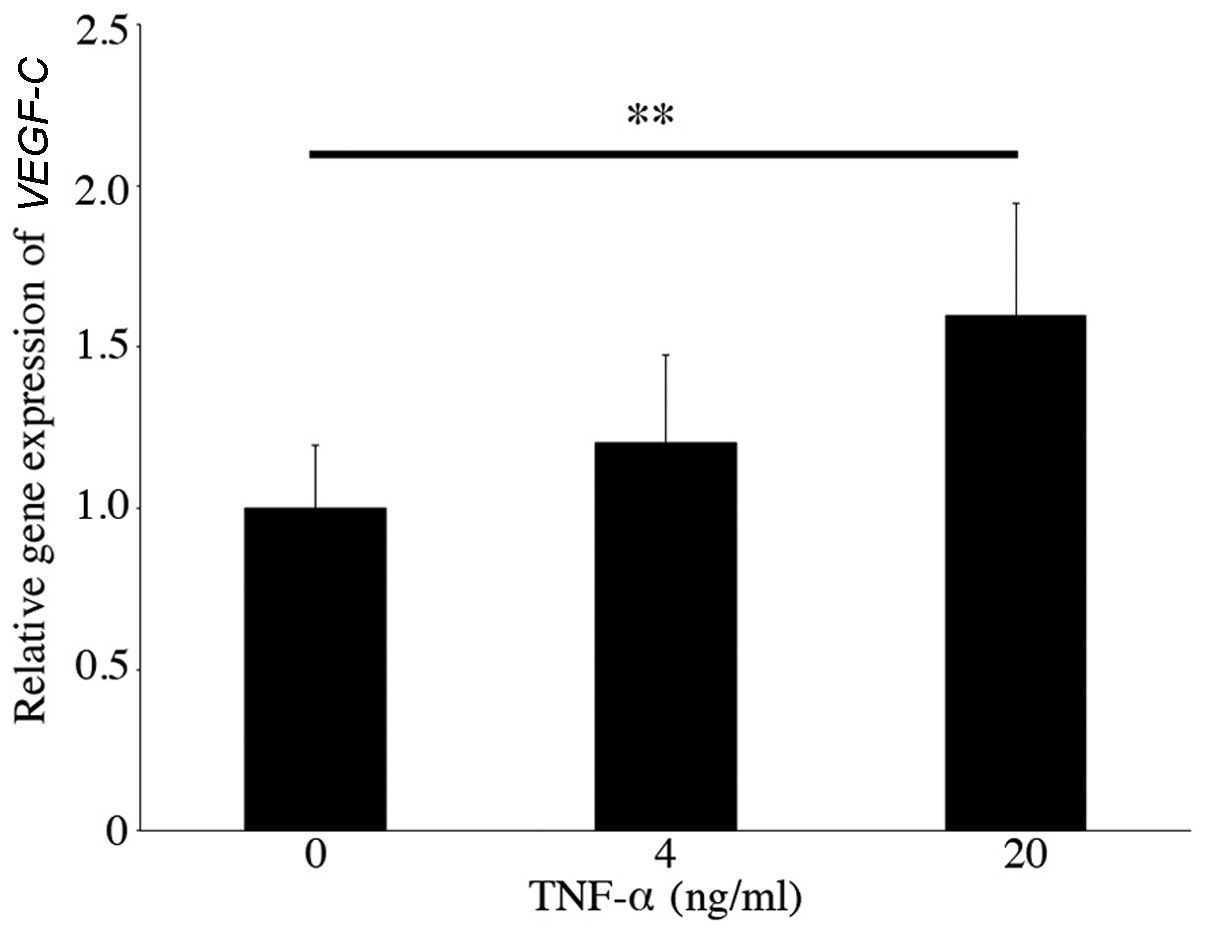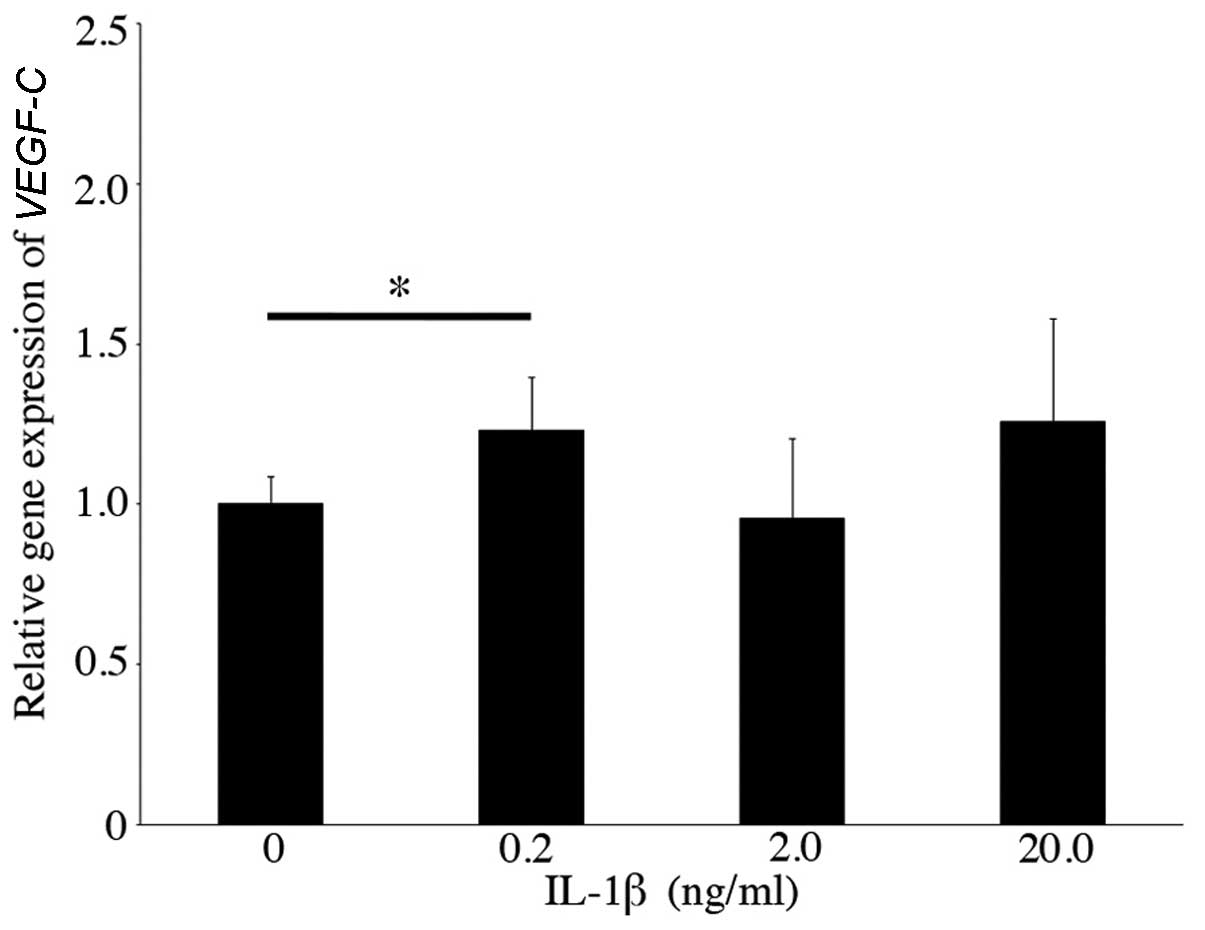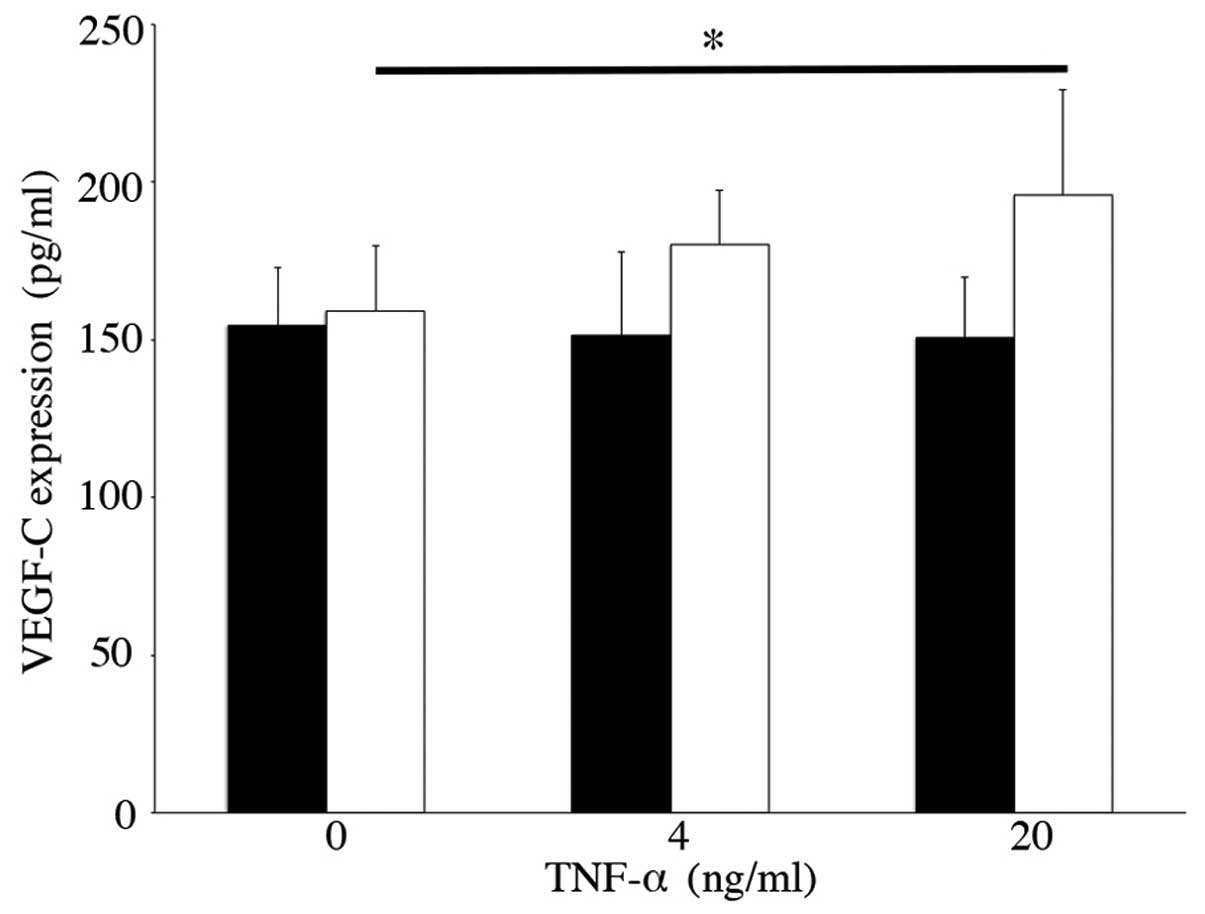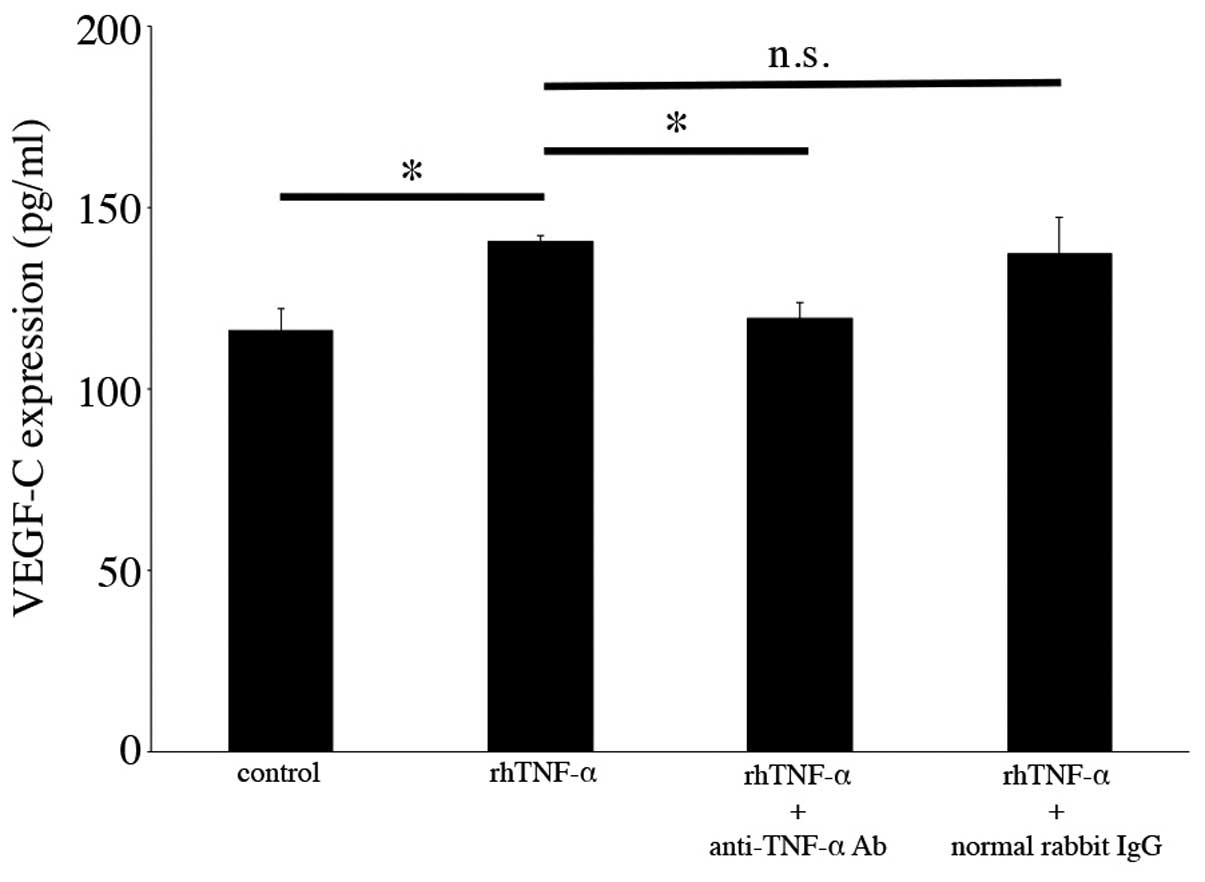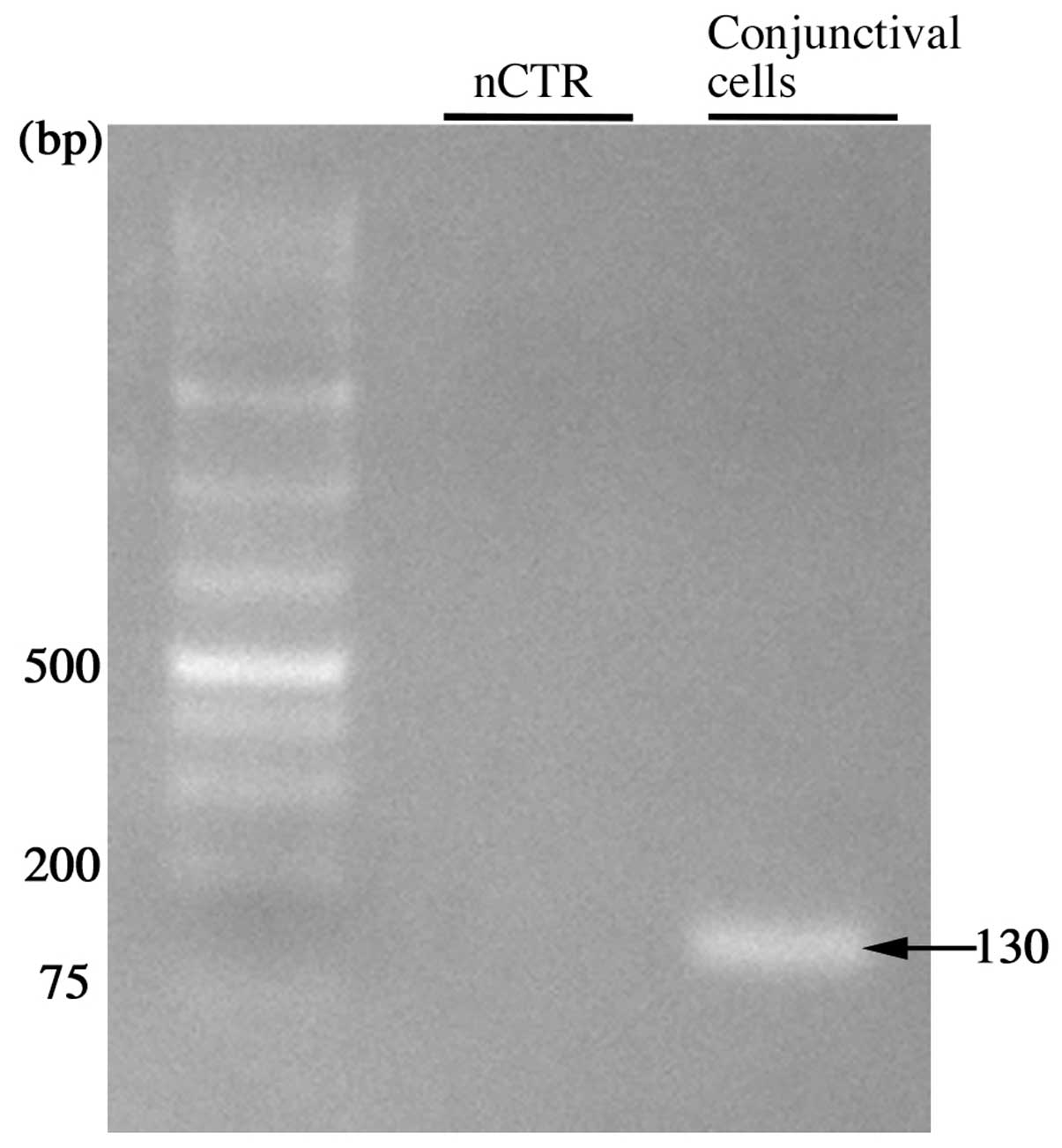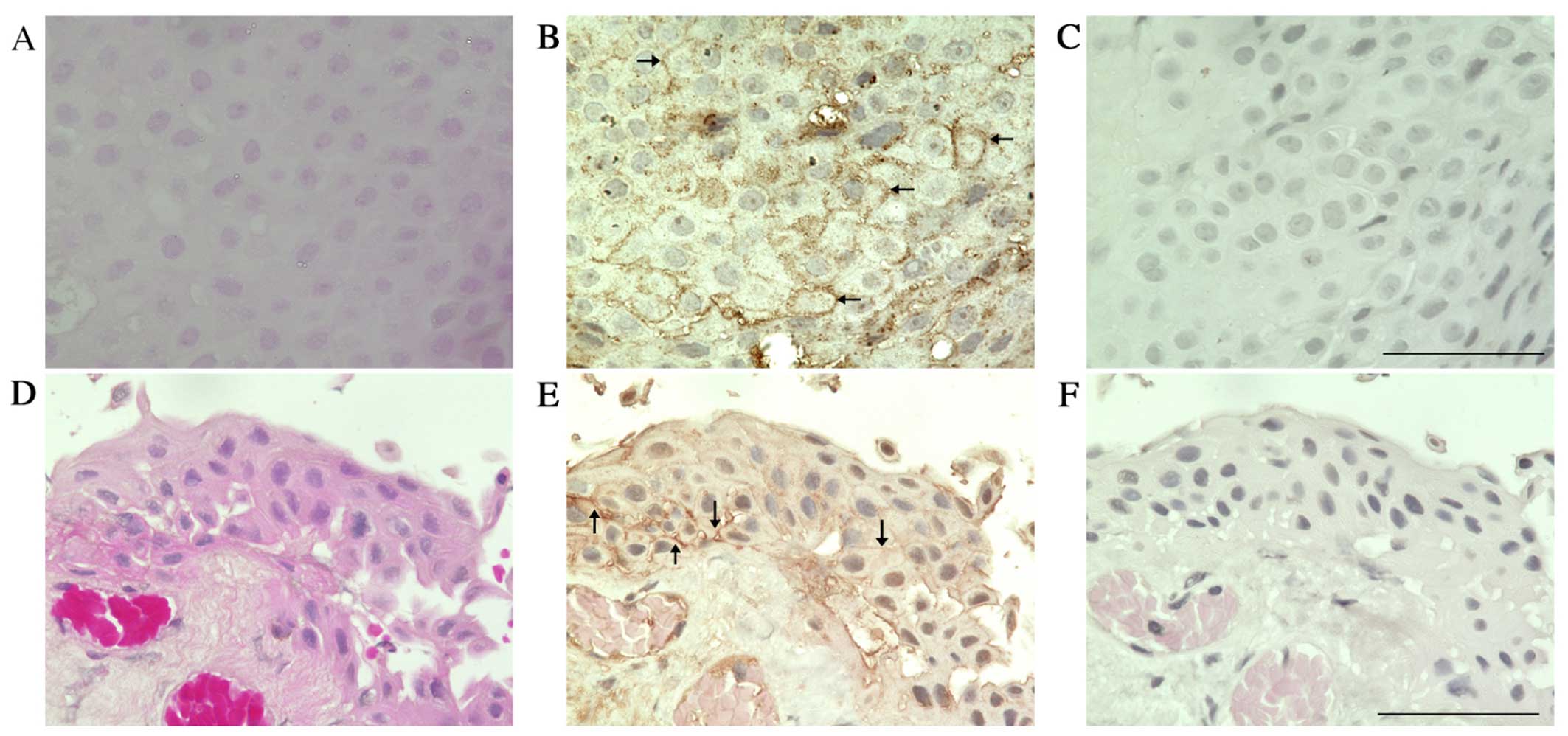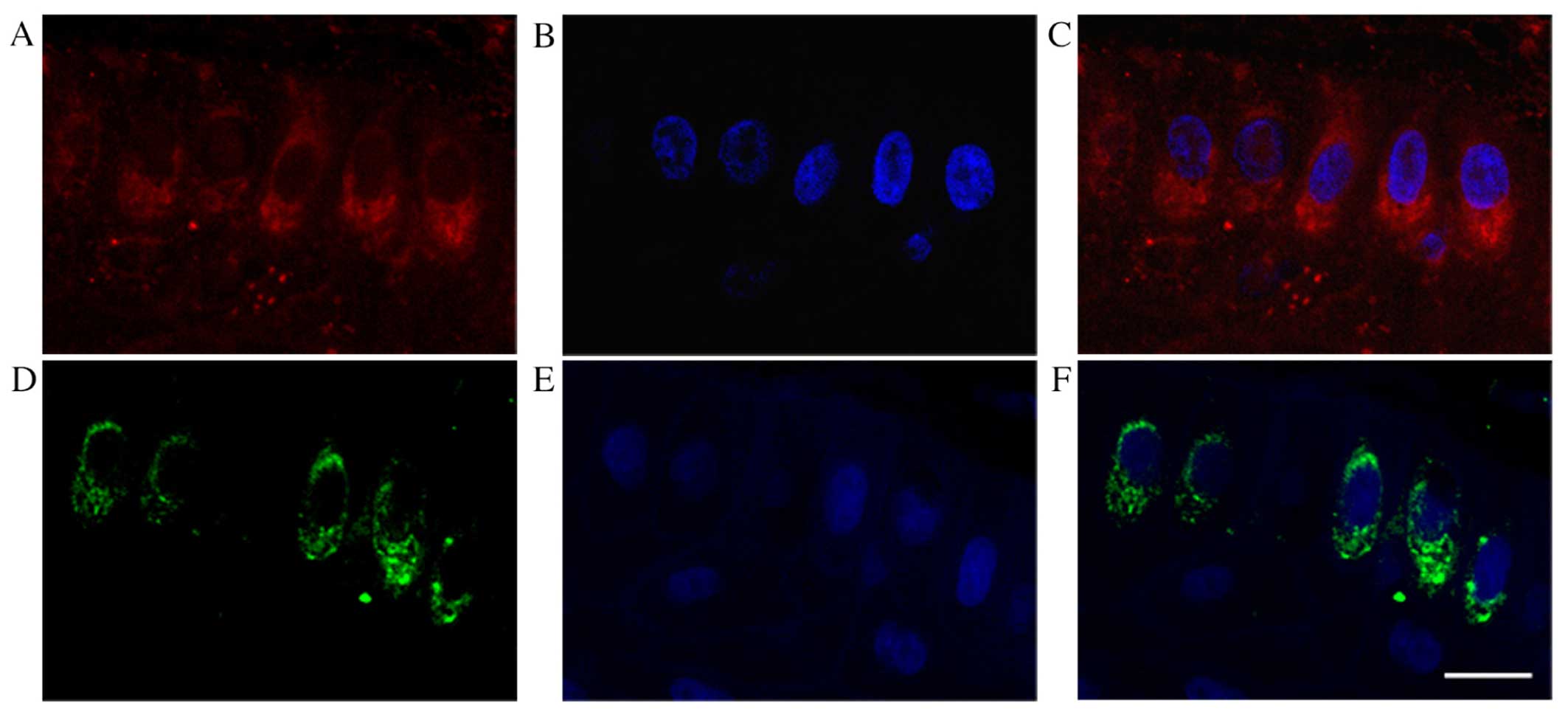Regulation of vascular endothelial growth factor-C by tumor necrosis factor-α in the conjunctiva and pterygium
- Authors:
- Published online on: June 16, 2016 https://doi.org/10.3892/ijmm.2016.2647
- Pages: 545-550
Abstract
Introduction
A pterygium is an ocular mass that forms over the perilimbal conjunctiva and extends onto the corneal surface. There are no specific eye drops available to prevent a pterygium from invading the cornea, which may cause subsequent visual impairment. Pathologically, pterygium tissues are characterized by a proliferative epithelium, an invasive nature and are highly vascularized tissues (1). We previously demonstrated that there was a high level of proliferation in the pterygium epithelium compared with that in normal conjunctiva (2,3). Vascular endothelial growth factor (VEGF)-A, basic fibroblast growth factor (FGF2) (4) and erythropoietin receptor (5) have been reported to exist at higher levels in pterygium tissues and lead to a pterygium extension through angiogenesis. Previous findings have shown that not only blood vessels but also lymphatic vessels may be clearly observed in human pterygium tissues; histological analyses proved that the lymphatic microvessel density (LMVD) was significantly higher in pterygia compared with that in normal conjunctiva (6,7). Lin et al demonstrated that the LMVD was an independent risk factor and a valuable predictive factor for the recurrence of pterygia (8). We recently demonstrated that VEGF-C and the VEGF receptor-3-signaling pathway led to lymphangiogenesis, which was associated with the pathogenesis and development of pterygia (7). However, the molecular mechanisms underlying elevated VEGF-C expression have yet to be elucidated in the conjunctiva and pterygium.
According to previous findings, chronic stimulation by the inflammatory cytokines tumor necrosis factor (TNF)-α and interleukin-1β (IL-1β) may be responsible for the increased expression of matrix metalloproteinases (MMPs) in cultured primary pterygium body fibroblasts (9). These data have clinical implications for the progression of pterygia and recurrence associated with the incomplete excision of primary fibroblasts under the influence of ocular surface inflammation (9). On the other hand, there was a highly significant correlation between VEGF-C and the levels of inflammatory cytokines such as TNF-α and IL-1β in the synovial fluid of patients with rheumatoid arthritis (RA). As a result, VEGF-C and the cytokines cause synovial inflammation and hyperplasia in RA by contributing to local lymphangiogenesis (10). The high expression of VEGF-C stimulated by TNF-α induces many human diseases such as chronic progressive kidney diseases (11), gallbladder carcinoma (12), melanoma lymph node metastasis (13) and breast cancer (14). Based on previous findings, we hypothesized that such inflammatory cytokines provoke VEGF-C expression in the human conjunctiva and pterygium.
The aim of this study was to analyze the changes in VEGF-C expression induced by TNF-α or IL-1β stimulation and to examine the relationship between VEGF-C and TNF receptor 1 (TNFR1) in the pterygium and normal conjunctival tissues of humans.
Materials and methods
Cell culture and chemicals
Cultured human conjunctival epithelial cells (clone 1-5c-4 HeLa derivative) were purchased from the European Collection of Authenticated Cell Cultures (Salisbury, UK). The cell line was cultured under a humidified atmosphere containing 5% CO2 at 37°C in Medium 199 (Sigma-Aldrich, St. Louis, MO, USA) containing 10% fetal bovine serum.
After serum starvation, human conjunctival epithelial cells were treated with recombinant human TNF-α (0, 4 and 20 ng/ml; R&D Systems, Minneapolis, MN, USA) or recombinant human IL-1β (0, 0.2, 2.0 and 20 ng/ml; Thermo Scientific Biomarkers, Hennigsdorf, Germany) for 24 and/or 48 h and processed for analysis to detect mRNA and protein expression levels. Phosphate-buffered saline (PBS) was added to the serum-free medium for the controls.
For the TNF-α neutralization bioassay, recombinant human TNF-α at 20 ng/ml (R&D Systems) was pre-incubated with 200 ng/ml of rabbit anti-TNF-α neutralizing antibody (D1B4; Cell Signaling Technology, Danvers, MA, USA) for 1 h at 37°C. After pre-incubation, the cells were treated for 48 h and processed for analysis to detect VEGF-C protein expression levels. Normal rabbit IgG (R&D Systems) was used as the control for the anti-TNF-α neutralizing antibody.
Quantitative PCR (qPCR) and reverse transcription-polymerase chain reaction (RT-PCR)
Total RNA was isolated from cells using the TRIzol method (Life Technologies, Carlsbad, CA, USA). Reverse transcription to synthesize 1.0 µg of total RNA to cDNA was performed using GoScript Reverse Transcriptase (Promega, Madison, WI, USA) according to the manufacturer's instructions.
qPCR was performed using 0.1 µl cDNA from each sample, GoTaq qPCR Master Mix (Promega), 0.25 µM primers and 0.2 µl CXR reference dye (Promega), in a final volume of 20 µl for the SYBR assay. For the TaqMan assay, we used 0.1 µl cDNA from each sample, THUNDERBIRD Probe qPCR Mix, 0.2 µl ROX reference dye (both from Toyobo, Tokyo, Japan), 0.9 µM of primers and 0.25 µM of FAM-dye labeled TaqMan MGB probe in a final volume of 20 µl. After an initial denaturation at 95°C for 2 min, the samples were subjected to 40 cycles of amplification comprised of denaturation at 95°C for 15 sec and annealing/extension at 60°C for 1 min. All data were calculated using the ΔΔCq method (15) using glyceraldehyde 3-phosphate dehydrogenase (GAPDH) for normalization.
RT-PCR was performed using 0.1 µl cDNA from each sample, 0.5 units of GoTaq DNA polymerase (Promega), 0.4 µM of primers, 0.2 mM of dNTP mix and 1X GoTaq reaction buffer in a final volume of 20 µl. After an initial denaturation at 95°C for 2 min, the samples were subjected to 35 cycles of amplification consisting of 95°C for 30 sec, 60°C for 30 sec and 72°C for 15 sec. The products were electrophoresed on 2% agarose gels, stained with SYBR Safe (Invitrogen, Carlsbad, CA, USA) and visualized using RAS-4000 image analyzer (FujiFilm, Tokyo, Japan).
The following primers for genes were used: human GAPDH (NM_002046.5) sense, 5′-CCT GGC CAA GGT CAT CCA TG-3′ and antisense, 5′-GGA AGG CCA TGC CAG TGA GC-3′ (224 bp); and TNF receptor superfamily, member 1A (TNFRSF1A; NM_001065.3) sense, 5′-CTG CCA GGA GA AAC AGA ACA C-3′ and antisense, 5′-CTC AAT CTG GGG TAG GCA CAA-3′ (130 bp). The TaqMan assay primer and probe set for VEGFC (NM_005429.3; TaqMan assay ID: Hs00153458_m1) was purchased from Life Technologies.
Enzyme-linked immunosorbent assay (ELISA)
The concentration of VEGF-C in cell cultured media was measured using the human VEGF-C ELISA kit (R&D Systems) according to the manufacturer's instructions.
Preparation of human tissues
Nasal pterygia were surgically removed from 10 patients (mean age, 73.6±5.6 years) who were enrolled in this study. Age-matched normal bulbar conjunctival tissues were obtained from patients (mean age, 62.3±4.2 years) during glaucoma surgery. The tissues were then fixed in 4% paraformaldehyde. After fixation, the slides were washed in PBS and processed for paraffin sectioning. This study was conducted in accordance with the World Medical Association Declaration of Helsinki. Written informed consent was obtained from all patients after receiving approval from the institutional review board of Hokkaido University Hospital (Sapporo, Japan) (IRB #014-0295).
Immunofluorescence microscopy
After hematoxylin and eosin staining (Sigma-Aldrich), formalin-fixed, paraffin-embedded serial tissue sections were deparaffinized and hydrated through exposure to xylene and graded alcohols followed by water. As a pre-treatment, microwave-based antigen retrieval was performed in a 10 mM citrate buffer (pH 6.0). The cultured human conjunctival epithelial cells were fixed in 4% paraformaldehyde and then washed in PBS. Ten percent serum depending on the secondary antibody source was used to block non-specific binding. The sections were incubated with the following primary antibodies: rabbit polyclonal anti-TNFR1 (ab19139; 1:100 dilution; Abcam, Cambridge, MA, USA) and goat polyclonal anti-VEGF-C (AF752; 1:10 dilution; R&D Systems). Secondary antibodies for fluorescence detection were Alexa Fluor 488 and 546 (Life Technologies). 4′,6-Diamidino-2-phenylindole (DAPI) was used for nuclear staining and sections were mounted with a fluorescent mounting medium (Dako, Glostrup, Denmark). The sections were visualized under a Keyence BZ-9000 fluorescence microscope (Keyence, Tokyo, Japan).
Immunohistochemistry
Following the microwave-based antigen retrieval treatment, the sections were incubated in 0.3% hydrogen peroxide in order to block endogenous peroxidase activity and 10% normal goat serum (Life Technologies) to block non-specific binding. The sections were then incubated with rabbit polyclonal anti-TNFR1 antibody (ab19139; 1:100 dilution; Abcam). We replaced anti-TNFR1 antibody with PBS as a negative control. Color was developed using 3,3′-diaminobenzidine tetrahydrochloride (Dako) and counter-stained with hematoxylin. The sections were examined under a Keyence BZ-9000 fluorescence microscope (Keyence).
Statistical analysis
All the results are expressed as the means ± SED as indicated. The student's t-test was used for statistical comparison of the concentration of VEGF-C protein. A p-value <0.05 was considered to indicate a statistically significant difference between the means.
Results
Increased expression and secretion of VEGF-C in cultured human conjunctival epithelial cells following TNF-α stimulation
Firstly, we examined the gene expression of VEGFC in cultured human conjunctival epithelial cells stimulated with TNF-α or IL-1β for 24 h. The VEGFC expression level increased (fold-change, 1.60±0.35, n=6, p<0.01) following stimulation with 20 ng/ml TNF-α (Fig. 1). By contrast, the gene expression of VEGFC mildly increased (fold-change, 1.23±0.17, n=6, p<0.05) with the addition of 0.2 ng/ml IL-1β (Fig. 2).
To determine whether stimulation with TNF-α or IL-1β increases VEGF-C secretion from cultured human conjunctival epithelial cells, we measured the VEGF-C protein concentrations in the supernatants 24 and 48 h after the addition of TNF-α or IL-1β. Forty-eight hours after the addition of 20 ng/ml TNF-α, the protein concentration of VEGF-C increased (195.92±33.41 pg/mg, n=6, p<0.05), which was significantly higher when compared with the controls (Fig. 3). By contrast, there was no significant difference in VEGF-C concentrations with or without IL-1β stimulation (data not shown).
Neutralization of TNF-α in VEGF-C secretion from cultured human conjunctival epithelial cells
To verify that TNF-α stimulation increases VEGF-C secretion from cultured human conjunctival epithelial cells, we treated the cultured cells with TNF-α and anti-TNF-α neutralizing antibody, and examined the secretion levels of VEGF-C. As shown in Fig. 4, increased VEGF-C protein secretion following TNF-α addition was significantly decreased by anti-TNF-α neutralizing antibody treatment (140.44±1.92 to 119.33±4.41 pg/ml, n=3, p<0.05), whereas there were no specific changes following treatment with normal rabbit IgG (200 ng/ml) (Fig. 4).
Expression of TNFR1 in cultured human conjunctival cells and pterygium tissues
TNF-α signaling occurs through two types of receptor, TNFR1 and TNFR2. TNFR1 is expressed in almost all mammalian cell types whereas TNFR2 is typically found in immune endothelial cells. Among numerous cell types, TNFR1 exists as the key mediator of TNF signaling except in the lymphoid system (16,17), as well as in other human conjunctival epithelial cell lines (18). In this study, we explored the existence of TNFR1 and the gene expression of TNFR1 (also known as TNFRSF1A) in cultured human conjunctival epithelial cells and pterygium tissues. TNFRSF1A was detected in cultured human conjunctival epithelial cells (Fig. 5). TNFR1 was also immunolocalized in cultured human conjunctival cells (Fig. 6); the TNFR1 signal was similar to that observed in the cultured dorsal root ganglion cell body (19). We then immunohistochemically examined TNFR1 expression in human tissues, in either pterygia or normal conjunctiva (Fig. 7). TNFR1 immunoreactivity was detected in the pterygium epithelial cells (Fig. 7B arrows), whereas the reactivity was less marked in normal conjunctival epithelia (Fig. 7E). Moreover, TNFR1 signals (Fig. 8D and F) were observed in VEGF-C-positive epithelial cells from human pterygia (Fig. 8A and C) using serial sections.
Discussion
In this study we demonstrated for the first time to the best of our knowledge, that stimulation by TNF-α, but not IL-1β, enhanced both the gene expression and the protein secretion of VEGF-C in cultured human conjunctival epithelial cells. It is known that TNF-α leads to cell proliferation in the pterygium by increasing the expression of MMPs (9). In addition, high levels of VEGF-C secretion from epithelial cells induces lymphangiogenesis, which play a critical role in the pathogenesis and development of pterygia (7). It has also been reported that immunoreactivity for TNF-α was marked in pterygium tissues (20). Therefore, our data suggest that TNF-α-mediated VEGF-C expression may be an important trigger of lymphangiogenesis during the development of pterygia.
It has been shown that TNFR1 is expressed by a variety of cell types (16,18,21). In this study, TNFRSF1A and TNFR1 were detected in cultured human conjunctival epithelial cells. Moreover, TNFR1 immunoreactivity was strongly detected in the pterygium tissues. In addition, we further demonstrated that TNFR1 immunoreactivity was detected in VEGF-C-positive epithelial cells from human pterygia. According to the immunoreactivity results, we hypothesized that VEGF-C was secreted from the TNFR1-positive cells. These results suggest that TNF-α possibly binds to TNFR1, which results in increased VEGF-C secretion and its gene expression.
TNFR1 immunoreactivity was found not only in epithelial cells from human pterygia but also in normal conjunctival epithelia. This result suggests that the increased expression of TNF-α rather than the constitutive presence of TNFR1 may stimulate the ligand-receptor system, which causes VEGF-C induction leading subsequently to a higher lymphatic vessel number in the pterygium than in the normal conjunctiva. According to previous findings, acute ultraviolet irradiation exposure results in the induction of cornea-derived proinflammatory cytokines such as IL-1, IL-6, IL-8 and TNF-α (22). It is generally known that pterygia are closely associated with ultraviolet light (23). Indeed, ultraviolet exposure may lead to an increase in the production of TNF-α in stromal cells of the human cornea (22). Exposure to ultraviolet light may be one of the regulators of TNF-α expression. Further studies are needed to clarify the regulation of TNF-α in the ocular surface.
Surgical resection of the proliferative tissues and subsequent reconstruction are the only conventional treatments for human pterygia. However, postoperative recurrence has been reported in >50% of cases (24). Therefore, the development of pharmacotherapy may contribute to the further prevention of pterygium invasion and subsequent recurrence. In this study, we demonstrated that TNF-α mediates VEGF-C expression, suggesting that blockage of TNF-α may be a novel therapeutic target for the treatment of pterygia in the future.
In conclusion, TNF-α induced VEGF-C expression in cultured human conjunctival epithelial cells. This pathway may involve the upstream regulation of VEGF-C expression and secretion in the pathogenesis and development of lymphangiogenesis in pterygia.
Acknowledgments
The present study was supported by the Japan Society for the Promotion of Science (JSPS) Grant-in-Aid for Young Scientists (B) (grant no. 24791824); and the Ministry of Education, Culture, Sports, Science and Technology (MEXT). We thank Ikuyo Hirose and Shiho Yoshida (Hokkaido University) for their skilled technical assistance.
References
|
Gebhardt M, Mentlein R, Schaudig U, Pufe T, Recker K, Nölle B, Al-Samir K, Geerling G and Paulsen FP: Differential expression of vascular endothelial growth factor implies the limbal origin of pterygia. Ophthalmology. 112:1023–1030. 2005. View Article : Google Scholar : PubMed/NCBI | |
|
Kase S, Takahashi S, Sato I, Nakanishi K, Yoshida K and Ohno S: Expression of p27(KIP1) and cyclin D1, and cell proliferation in human pterygium. Br J Ophthalmol. 91:958–961. 2007. View Article : Google Scholar | |
|
Kase S, Osaki M, Sato I, Takahashi S, Nakanishi K, Yoshida K, Ito H and Ohno S: Immunolocalisation of E-cadherin and beta-catenin in human pterygium. Br J Ophthalmol. 91:1209–1212. 2007. View Article : Google Scholar : PubMed/NCBI | |
|
Detorakis ET, Zaravinos A and Spandidos DA: Growth factor expression in ophthalmic pterygia and normal conjunctiva. Int J Mol Med. 25:513–516. 2010. View Article : Google Scholar : PubMed/NCBI | |
|
Kase S, Osaki M, Jin XH, Ohgami K, Yoshida K, Saito W, Takahashi S, Nakanishi K, Ito H and Ohno S: Increased expression of erythropoietin receptor in human pterygial tissues. Int J Mol Med. 20:699–702. 2007.PubMed/NCBI | |
|
Ling S, Liang L, Lin H, Li W and Xu J: Increasing lymphatic microvessel density in primary pterygia. Arch Ophthalmol. 130:735–742. 2012. View Article : Google Scholar : PubMed/NCBI | |
|
Fukuhara J, Kase S, Ohashi T, Ando R, Dong Z, Noda K, Ohguchi T, Kanda A and Ishida S: Expression of vascular endothelial growth factor C in human pterygium. Histochem Cell Biol. 139:381–389. 2013. View Article : Google Scholar | |
|
Lin H, Luo L, Ling S, Chen W, Liu Z, Zhong X, Wu C, Chen W and Liu Y: Lymphatic microvessel density as a predictive marker for the recurrence time of pterygium: a three-year follow-up study. Mol Vis. 19:166–173. 2013.PubMed/NCBI | |
|
Solomon A, Li DQ, Lee SB and Tseng SC: Regulation of collagenase, stromelysin, and urokinase-type plasminogen activator in primary pterygium body fibroblasts by inflammatory cytokines. Invest Ophthalmol Vis Sci. 41:2154–2163. 2000.PubMed/NCBI | |
|
Cha HS, Bae EK, Koh JH, Chai JY, Jeon CH, Ahn KS, Kim J and Koh EM: Tumor necrosis factor-alpha induces vascular endothelial growth factor-C expression in rheumatoid synoviocytes. J Rheumatol. 34:16–19. 2007.PubMed/NCBI | |
|
Kimura H, Mikami D, Kamiyama K, Sugimoto H, Kasuno K, Takahashi N, Yoshida H and Iwano M: Telmisartan, a possible PPAR-δ agonist, reduces TNF-α-stimulated VEGF-C production by inhibiting the p38MAPK/HSP27 pathway in human proximal renal tubular cells. Biochem Biophys Res Commun. 454:320–327. 2014. View Article : Google Scholar : PubMed/NCBI | |
|
Du Q, Jiang L, Wang X, Wang M, She F and Chen Y: Tumor necrosis factor-α promotes the lymphangiogenesis of gallbladder carcinoma through nuclear factor-κB-mediated upregulation of vascular endothelial growth factor-C. Cancer Sci. 105:1261–1271. 2014. View Article : Google Scholar : PubMed/NCBI | |
|
Peppicelli S, Bianchini F and Calorini L: Inflammatory cytokines induce vascular endothelial growth factor-C expression in melanoma-associated macrophages and stimulate melanoma lymph node metastasis. Oncol Lett. 8:1133–1138. 2014.PubMed/NCBI | |
|
Wen Y, Wang M, Yang J, Wang Y, Sun H, Zhao J, Liu W, Zhou Z, Deng H, Castillo-Pedraza C, et al: A comparison of fentanyl and flurbiprofen axetil on serum VEGF-C, TNF-α, and IL-1β concentrations in women undergoing surgery for breast cancer. Pain Pract. 15:530–537. 2015. View Article : Google Scholar | |
|
Livak KJ and Schmittgen TD: Analysis of relative gene expression data using real-time quantitative PCR and the 2(-Delta Delta C(T)). Method Methods. 25:402–408. 2001. View Article : Google Scholar | |
|
Brenner D, Blaser H and Mak TW: Regulation of tumour necrosis factor signalling: live or let die. Nat Rev Immunol. 15:362–374. 2015. View Article : Google Scholar : PubMed/NCBI | |
|
Wajant H, Pfizenmaier K and Scheurich P: Tumor necrosis factor signaling. Cell Death Differ. 10:45–65. 2003. View Article : Google Scholar : PubMed/NCBI | |
|
Cook EB, Stahl JL, Graziano FM and Barney NP: Regulation of the receptor for TNFalpha, TNFR1, in human conjunctival epithelial cells. Invest Ophthalmol Vis Sci. 49:3992–3998. 2008. View Article : Google Scholar : PubMed/NCBI | |
|
Richards N, Batty T and Dilley A: CCL2 has similar excitatory effects to TNF-α in a subgroup of inflamed C-fiber axons. J Neurophysiol. 106:2838–2848. 2011. View Article : Google Scholar : PubMed/NCBI | |
|
Kria L, Ohira A and Amemiya T: Immunohistochemical localization of basic fibroblast growth factor, platelet derived growth factor, transforming growth factor-beta and tumor necrosis factor-alpha in the pterygium. Acta Histochem. 98:195–201. 1996. View Article : Google Scholar : PubMed/NCBI | |
|
Sakimoto T, Yamada A and Sawa M: Release of soluble tumor necrosis factor receptor 1 from corneal epithelium by TNF-alpha-converting enzyme-dependent ectodomain shedding. Invest Ophthalmol Vis Sci. 50:4618–4621. 2009. View Article : Google Scholar : PubMed/NCBI | |
|
Kennedy M, Kim KH, Harten B, Brown J, Planck S, Meshul C, Edelhauser H, Rosenbaum JT, Armstrong CA and Ansel JC: Ultraviolet irradiation induces the production of multiple cytokines by human corneal cells. Invest Ophthalmol Vis Sci. 38:2483–2491. 1997.PubMed/NCBI | |
|
Yam JC and Kwok AK: Ultraviolet light and ocular diseases. Int Ophthalmol. 34:383–400. 2014. View Article : Google Scholar | |
|
Díaz L, Villegas VM, Emanuelli A and Izquierdo NJ: Efficacy and safety of intraoperative mitomycin C as adjunct therapy for pterygium surgery. Cornea. 27:1119–1121. 2008. View Article : Google Scholar : PubMed/NCBI |



